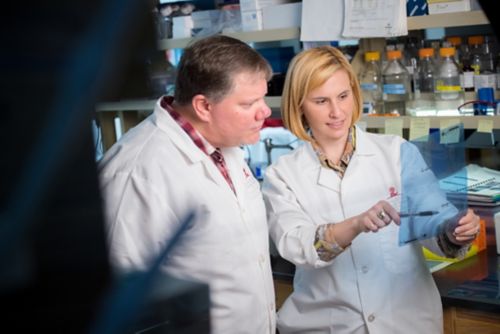St. Jude Family of Websites
Explore our cutting edge research, world-class patient care, career opportunities and more.
St. Jude Children's Research Hospital Home

- Fundraising
St. Jude Family of Websites
Explore our cutting edge research, world-class patient care, career opportunities and more.
St. Jude Children's Research Hospital Home

- Fundraising
Exploring the Sonic Hedgehog pathway – how embryonic cells broadcast their growth instructions

Stacey Ogden, PhD, right, and Daniel Stewart, PhD, explore how malfunctions in the Sonic Hedgehog pathway can lead to different types of cancer.
Our laboratory concentrates on understanding a central biological pathway, called the Sonic Hedgehog pathway, that controls embryonic development in organisms from the fruit fly to humans. We concentrate on learning the basics of how the pathway functions during normal development: how the protein signaling molecules in the pathway turn on and off at the right time, and how they transmit their signals to cause embryonic cells to mature into specialized cells as the embryo develops into a functioning organism.
We’re exploring this pathway because, besides its basic biological importance, it can play a major role in cancer. For example, 30% of pediatric brain tumors called medulloblastomas have an abnormally activated Sonic Hedgehog pathway. In adults, Hedgehog pathway hyperactivation also causes basal cell carcinoma, the most common skin cancer and one of the most common cancers. So, if we better understand how it functions normally, we can understand how it malfunctions to drive cancer.
Researchers have come a long way in understanding the Sonic Hedgehog pathway since I started my research. At first, all we knew was that there was this biological switch, dubbed the hedgehog protein, that somehow activated a cellular signaling pathway that controlled how cells “decided” to become specialized cells as the embryo developed. However, over the last 15 years or so, our knowledge has really expanded, and now we know how many of the protein switches work; but there is still so much we don’t know.
St. Jude Children’s Research Hospital offers a wonderful research environment to explore those mysteries, both because of its strength in basic research and because of its commitment to understanding how Sonic Hedgehog signaling contributes to cancer. We believe that from our basic understanding will come treatment advances—urgently needed because in the case of medulloblastoma, the current treatments using surgery, radiation and chemotherapy can cause severe side effects.
Our latest research, published in the journal eLife, shows the kind of new research insights that could potentially lead to new targeted treatments. In our studies, we explored the regulation of a protein called Dispatched, which functions to deploy Hedgehog signaling molecules from the producing cells to the target cells. Once received by those target cells, Hedgehog proteins activate a set of target genes that are crucial for the embryo’s growth. This communication among cells is critical for the intricate process by which the embryo transforms from a small collection of cells into a complex, functioning organism.
Dispatched is embedded in the signaling cell membrane where it releases Hedgehog ligands from the cell membrane, so they can travel to signal-receiving cells. Our explorations of the Dispatched machinery using cell cultures and fruit flies revealed the first details of how an enzyme called Furin activates Dispatched by cleaving it at a specific point on the molecule.
Understanding Dispatched could have relevance to understanding cancers, because many solid tumors—even if they’re not themselves driven by abnormal hedgehog signaling—secrete Sonic Hedgehog to surrounding cells to make the affected tissue more conducive to the tumor’s growth. So, if we could identify a target for drugs to selectively silence the Dispatched machinery—perhaps by stopping it from being activated by being cleaved—it could cripple tumor growth, but allow healthy cells to continue to thrive.
As with all research, our finding with Dispatched helps us progress to tackle even more mysteries surrounding the Sonic Hedgehog pathway. For example, the development of the embryo requires its cells to be exposed to a gradient of concentrations of Hedgehog signaling molecules to activate appropriate target genes at the correct time and place in a developing tissue for organ development to succeed. Although we know that Dispatched is essential for establishing this Hedgehog gradient, we still don’t know how that works.
Stay tuned!
Read the full article:
Cleavage activate Dispatched for Sonic Hedgehog ligand release. eLife 7:e31678, 2018.






